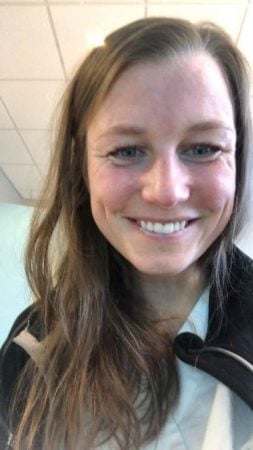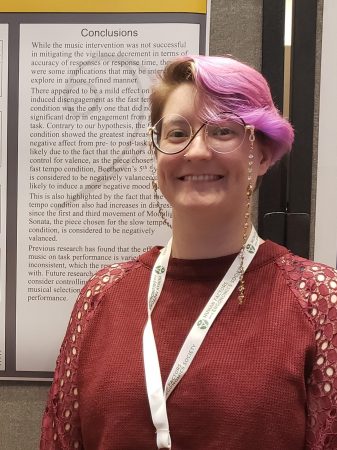Each spring, Michigan Tech’s Graduate Student Government sponsors the Graduate Research Colloquium (GRC) Poster and Presentation Competition. The GRC offers a unique opportunity for graduate students to showcase their research with the University community and work on their presentation skills for other professional events. Students give oral presentations, present posters, or do both. Judges from a similar field as the presenters score the presentations. The judges also provide valuable insight and feedback on how the students can improve their presentations. The presenters are grouped into different technical sessions, according to their discipline of study.
Applied Cognitive Science and Human Factors (ACSHF) PhD students Anne Inger Mortvedt, Isaac Flint, and Lauren Sprague will give their oral presentations at 1:00pm Wednesday, March 29 in the MUB Alumni Lounge. Lauren will also participate in the poster presentations from 5:00-6:00pm in the Rozsa Lobby, along with ACSHF MS student Nishat Binte Alam.
See abstracts below for more details regarding their research.
Relationship between Program Usability Characteristics and Intention to Use: Preliminary Data Implementing a Sport Injury Prevention Program by Anne Inger Mortvedt.
Adherence to exercise programs is low across multiple populations. For example, within the target population for ACL injuries, only ~4-20 % of sports teams have implemented evidence-based injury prevention programs. This study explored the relationship between usability characteristics and implementation likelihood for a newly developed ACL injury prevention program.
Twenty-two female handball players, aged 14 to 16, participated in the intervention study. Data on usability characteristics was collected through a modified usability scale similar to the System Usability Scale. Subcomponents of the usability scale included learnability, perceived effectiveness, ease of use, enjoyability and efficiency. Analyses on the total usability scale score revealed a significant difference between pre and post intervention responses, indicating that overall usability decreased over time (p < 0.005). Enjoyability was the subcomponent that primarily drove this change.
Total scale scores were significantly correlated with intention to use/implementation likelihood (Spearman’s rho .54, p = .009). Perceived effectiveness and enjoyability were significantly correlated with intention to use the program (rho 0.50, p = 0.02 and rho 0.50, p= 0.02, respectively), indicating that program adherence is affected by whether they believe the program will work (e.g., reduce injuries) and whether they enjoy performing the program. We did not find any significant relationships between the three other subcomponents (e.g., learnability, ease of use and efficiency) and intention to use.
This preliminary data suggests that program designers may want to make sure participants understand why it is important to perform the program, in addition to developing an exercise program that they seem to enjoy performing. Future studies should capture more data on the usability scale/subscales to ensure the factor structure is consistent and items display appropriate psychometric properties.
Pilot test of critical flicker fusion in combination with functional near infrared spectroscopy (fNIRS) in order to accurately measure cognitive workload during a visuospatial vigilance task by Lauren Sprague [abstract unavailable prior to post]
Exploring the difference in Movement Corrections following Visual and Physical perturbations by Isaac Flint
Making online movement corrections is vital to a person’s ability to navigate the environments they live in. Failures often result in injury, such as tripping, car collisions, or bumping into hazardous surfaces. This experiment explores the behavioral (movement characteristics) and cortical (EEG) responses following two types of perturbations to arm-reaching movements, with a sample of young adult Michigan Tech students. Visual perturbations were administered by changing the visual location of a curser compared to a participant’s hand position during random experimental trials. Physical (mechanical) perturbations were administered via a robotic arm that unexpectedly moved participants’ arms during other random experimental trials. These experimental trials were further divided into two sizes of perturbations.
One size that placed the cursor outside of a set of obstacles, and one where the perturbation put the cursor on a collision course if the participant did not make a movement correction. Our results show that the type and size of perturbation had an impact on not only the behavioral characteristics of the movement corrections, but also the EEG event-related potentials that followed the perturbation. Differences were also observed for trials with collisions and trials without collisions. These results are a step toward understanding the neuro-cognitive correlates of online movement corrections. This knowledge will inform future work assessing how age and cognitive declines in an aging population may affect their ability to make successful movement corrections.
Types of Questions Teachers Ask to Engage Students in Making Sense of a Student Contribution by Nishant Binte Alam
In the student center classroom, where teachers constantly make decisions based on what is happening surrounding them, what they are noticing, and how they are interpreting student contributions, a teacher’s interpretation and response to student mathematical contributions plays an important role to shape and direct students’ thinking.
In particular, failing to ask productive questions that help students to engage in a sense-making discussion could deteriorate cognitive opportunities. This research is planning to study what types of questions teachers indicate they would ask to engage students in making sense of a high-leverage student mathematical contribution, what Leatham et al. (2015) refer to as a MOST (Mathematically Significant Pedagogical Opportunities to Build on Student Thinking) and their reasoning about why particular questions are or are not productive. In this study, a scenario-based survey questionnaire will be sent via email to 100 middle and high school teachers. In the given scenario, a MOST has surfaced, and teachers will be asked three questions about how they would respond in the scenario.
This research could lead us to determine if teachers are selecting the questions which are likely to be productive in supporting students’ mathematical thinking and why they select the questions that they do. Knowing this will inform future work with teachers to productively use student thinking in their teaching.
For a complete list of oral and poster presentations see 2023 Abstract Booklet.
No other graduate program influences the next generation like ACSHF. At Michigan tech, we address applied cognitive science problems by using basic research in applied settings to bridge the gap between people and technology. Program specializations span the interests of multiple faculty and research groups who work in state-of-the-art labs. For more information, contact ACSHF graduate program director Kevin Trewartha.




